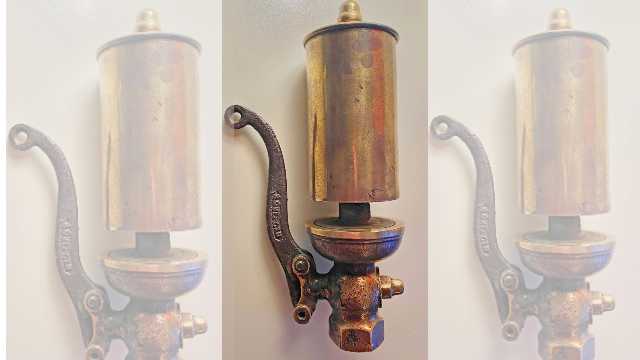By Sterling McGinn
In the early days of Newberry and surrounding sawmill towns, the clangs and toots of whistles and bells created a soundtrack that kept the community right on time.
Their loud noises alerted the residents of shift changes and lunch periods of the mills and factories, fire or other disasters, the beginning and end of a school day and Sunday church services.
Large brass steam whistles fitted to the roofs of the mills and powered by the big steam engines sounded the beginning of the day shift at the sawmills of the Charcoal Iron Company, Barrett’s, Horner Flooring, the Dollarville sawmill and others. Those whistles sounded at 6 a.m. for day shift workers.
A toot at 8 a.m. got the children on their way to school and to keep the 8 a.m. shifts on time.
The whistles blew again for the noon lunch hour at mills and to alert the end of lunch.
Probably the favorite whistle for the day shift crew was the 4 p.m. shift change to end their workday. The night shift would also begin to the tune of the whistle. Those with no night shifts kept a watchman to check on the steam engines and other equipment.
The brass whistles usually ran on 150 pounds-per-square-inch of steam pressure. Sometimes, the individual responsible for sounding the whistle would call the telephone operator for the correct time.
At one time in Newberry’s history, four Duluth South Shore and Atlantic Railroad passenger and freight trains came and went through Newberry. When arriving at the South Shore Depot in Newberry, a deep-voiced locomotive whistle indicated the approach of the train and passengers to board or exit the train. A bell also rang when the train approached the station and at all crossings. On leaving the depot, the big whistle signified the train was leaving.
Sunday worship services began with the clang of bells. Probably one of the first church bells was given to the First Presbyterian Church in 1886. The Presbyterian Church was started in 1883 and was the first organized congregation in the one-year-old town of Newberry.
The Ladies’ Aid Society had intended to raise funds to purchase a church bell, however, Mrs. John S. Newberry of Detroit offered to buy a bell before the society had raised enough money.
The new bell, weighing 500 pounds, was manufactured by Clinton H. Meneely Bell Co. of Troy, New York. This bell is inscribed “Presented by Mrs. John S. Newberry to First Presbyterian Church of Newberry August, 1886. ‘Come, Let us Worship.’” The bell is still atop the Presbyterian Church.
Members of the Newberry Fire Department relied on some type of alerting device to dispatch them to the fire house. Until the 1980s or 90s, firefighters did not have pagers.
The Newberry department, organized in 1886, used a large bell installed at the village hall on East John Street. On at least one occasion, Chief Dan McLeod set up a bonfire in a vacant lot in the village and rang the bell to time the response of his crew. The Newberry News opined that the citizens were rudely awakened by the bell in the middle of the night.
Later, a steam whistle was used to dispatch the fire department. Residents would call the Water and Light Plant, where an operator was stationed. The caller would tell their name and address and location of the fire. A general whistle was given followed by a ward signal.
There were six fire wards and the number of whistles blown indicated the ward number. But, in 1922, a busy phone operator blew the wrong signal, rushing the firefighters to the east side of Newberry when the fire was on the west side. Thankfully, the homeowner was able to extinguish his stove fire before it spread.
The fire whistle also notified the chronic fire chasers where the fire was. In the 1940s, an intoxicated individual called in a false alarm at Four Mile Corner. A Sault Evening News article noted that many cars followed the fire department to the false alarm.
“It was reported that over 100 cars made the eight-mile round trip, and their licenses were recorded as Newberry citizens were asked not to follow the fire trucks and cause congestion, or to be calling in on the telephone asking where the fire is,” the article read.
Atlas Plywood had the biggest whistle in town. Newberry resident Larry Matelski remembers that whistle going off at ten minutes to 8 a.m., 1 p.m. and 5 p.m.
“There was an 8 p.m. curfew whistle for kids 16 and under,” Matelski recalled. “There was some leniency if there was an evening basketball game or dance, but you had to go home right after.”
Matelski also remembers that there was a red light on the light pole in front of the Masonic Lodge. The village police did not have radios at that time, and if the Michigan State Police needed the village police, the red light being on would mean they needed to go to the State Police Post.
By the 1950s, much of the noises of the town were just memories. Steam engines were no longer used. The Charcoal Iron Co. closed in 1945 and remaining mills had modernized. The fire whistle was changed to an air-raid type siren.
Though mornings and evenings are quieter in the modern era, a few church bells still ring on Sunday morning—the modern air horn-type train horns are still heard daily, and workers watch their iPhones and smartwatches to get to work on time.
The fire siren still blows on Saturdays at noon by Central Dispatch, and occasionally when there is a fire. The old town fire bell is proudly displayed in front of Newberry’s Peter Rahilly fire station.












